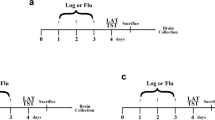Abstract
Impairment of serotonergic neurotransmission is the major factor responsible for depression and glycogen synthase kinase 3β (GSK-3β) participates in serotonergic transmission-mediated signaling networks relevant to mental illnesses. In the forced-swim test to assess depression-like behavior, the immobility time for mice with restraint stress was significantly longer than that for nonstressed control mice. Postsynaptic cell surface localization of 5-HT1A receptor, but not 5-HT2A receptor, in the hypothalamus for mice with restraint stress was significantly reduced as compared with that for control mice, which highly correlated to prolonged immobility time, i.e., depression-like behavior. The linoleic acid derivative 8-[2-(2-pentyl-cyclopropylmethyl)-cyclopropyl]-octanoic acid (DCP-LA) restored restraint stress-induced reduction of cell surface 5-HT1A receptor and improved depression-like behavior in mice with restraint stress. Moreover, DCP-LA stimulated serotonin release from hypothalamic slices and cancelled restraint stress-induced reduction of GSK-3β phosphorylation at Ser9. Taken together, the results of the present study indicate that DCP-LA could ameliorate depression-like behavior by promoting translocation of 5-HT1A receptor to the plasma membrane on postsynaptic cells, stimulating serotonin release, and inactivating GSK-3β.









Similar content being viewed by others
References
Kessler RC, Berglund P, Demler O, Jin R, Koretz D, Merikangas KR, Rush AJ, Walters EE, Wang PS (2003) The epidemiology of major depressive disorder: results from the National Comorbidity Survey Replication (NCS-R). JAMA 289(23):3095–3105
Zarate C, Duman RS, Liu G, Sartori S, Quiroz J, Murck H (2003) New paradigms for treatment-resistant depression. Ann N Y Acad Sci 1292:21–31
Jans LA, Riedel WJ, Markus CR, Blokland A (2007) Serotonergic vulnerability and depression: assumptions, experimental evidence and implications. Mol Psychiatry 12(6):522–543
Hoyer D, Hannon JP, Martin GR (2002) Molecular, pharmacological and functional diversity of 5-HT receptors. Pharmacol Biochem Behav 71(4):533–554
Lesch KP, Gutknecht L (2004) Focus on The 5-HT1A receptor: emerging role of a gene regulatory variant in psychopathology and pharmacogenetics. Int J Neuropsychopharmacol 7(4):381–385
Sharp T, Boothman L, Raley J, Queree P (2007) Important messages in the ‘post’: recent discoveries in 5-HT neurone feedback control. Trends Pharmacol Sci 28(12):629–636
Savitz J, Lucki I, Drevets w (2009) 5-HT1A receptor function in major depressive disorder. Prog Neurobiol 88(1):17–31
Albert PR, Le François B, Millar AM (2011) Transcriptional dysregulation of 5-HT1A autoreceptors in mental illness. Mol Brain 4:21
Latapy C, Rioux V, Guitton MJ, Beaulieu JM (2012) Selective deletion of forebrain glycogen synthase kinase 3β reveals a central role in serotonin-sensitive anxiety and social behaviour. Philos Trans R Soc Lond B Biol Sci 367(1601):2460–2474
Li X, Jope RS (2010) Is glycogen synthase kinase-3 a central modulator in mood regulation? Neuropsychopharmacology 35(11):2143–2154
Polter AM, Yang S, Jope RS, Li X (2012) Functional significance of glycogen synthase kinase-3 regulation by serotonin. Cell Signal 24(1):265–271
Beaulieu JM, Gainetdinov RR, Caron MG (2009) Akt/GSK3 signaling in the action of psychotropic drugs. Annu Rev Pharmacol Toxicol 49:327–347
Tanaka A, Nishizaki T (2003) The newly synthesized linoleic acid derivative FR236924 induces a long-lasting facilitation of hippocampal neurotransmission by targeting nicotinic acetylcholine receptors. Bioorg Med Chem Lett 13(6):1037–1040
Kanno T, Yamamoto H, Yaguchi T, Hi R, Mukasa T, Fujikawa H, Nagata T, Yamamoto S, Tanaka A, Nishizaki T (2006) The linoleic acid derivative DCP-LA selectively activates PKC-ε, possibly binding to the phosphatidylserine binding site. J Lipid Res 47(6):1146–1156
Shimizu T, Kanno T, Tanaka A, Nishizaki T (2011) α, β-DCP-LA selectively activates PKC-ε and stimulates neurotransmitter release with the highest potency among 4 diastereomers. Cell Physiol Biochem 27(2):149–158
Kanno T, Tanaka A, Nishizaki T (2012) Linoleic acid derivative DCP-LA stimulates vesicular transport of α7 ACh receptors towards surface membrane. Cell Physiol Biochem 30(1):75–82
Kanno T, Tsuchiya A, Tanaka A, Nishizaki T (2013) The linoleic acid derivative DCP-LA increases membrane surface localization of the α7 ACh receptor in a protein 4.1N-dependent manner. Biochem J 450(2):303–309
Kanno T, Yaguchi T, Yamamoto S, Yamamoto H, Fujikawa H, Nagata T, Tanaka A, Nishizaki T (2005) 8-[2-(2-pentyl-cyclopropylmethyl)-cyclopropyl]-octanoic acid stimulates GABA release from interneurons projecting to CA1 pyramidal neurons in the rat hippocampus via pre-synaptic α7 acetylcholine receptors. J Neurochem 95(3):695–702
Yamamoto S, Kanno T, Nagata T, Yaguchi T, Tanaka A, Nishizaki T (2005) The linoleic acid derivative FR236924 facilitates hippocampal synaptic transmission by enhancing activity of presynaptic α7 acetylcholine receptors on the glutamatergic terminals. Neuroscience 130(1):207–213
Kanno T, Tsuchiya A, Shimizu T, Tanaka A, Nishizaki T (2012) Indomethacin serves as a potential inhibitor of protein phosphatases. Cell Physiol Biochem 30(4):1014–1022
Kanno T, Yaguchi T, Nagata T, Tanaka A, Nishizaki T (2009) DCP-LA stimulates AMPA receptor exocytosis through CaMKII activation due to PP-1 inhibition. J Cell Physiol 221(1):183–188
Cowen DS, Johnson-Farley NN, Travkina T (2005) 5-HT receptors couple to activation of Akt, but not extracellular-regulated kinase (ERK), in cultured hippocampal neurons. J Neurochem 93(4):910–917
Disclosure Statement
The authors state that there are no actual or potential conflicts of interest.
Author information
Authors and Affiliations
Corresponding author
Rights and permissions
About this article
Cite this article
Kanno, T., Tanaka, A. & Nishizaki, T. Linoleic Acid Derivative DCP-LA Ameliorates Stress-Induced Depression-Related Behavior by Promoting Cell Surface 5-HT1A Receptor Translocation, Stimulating Serotonin Release, and Inactivating GSK-3β. Mol Neurobiol 51, 523–532 (2015). https://doi.org/10.1007/s12035-014-8718-5
Received:
Accepted:
Published:
Issue Date:
DOI: https://doi.org/10.1007/s12035-014-8718-5




